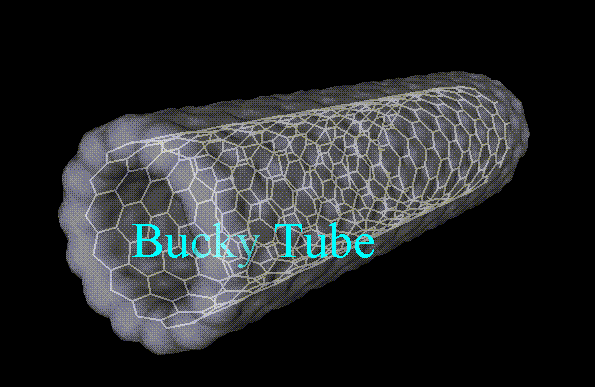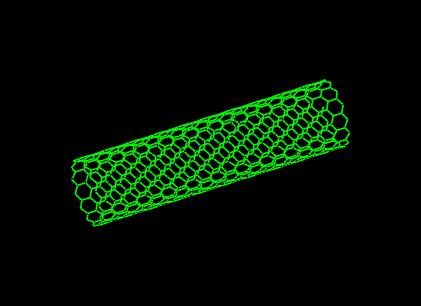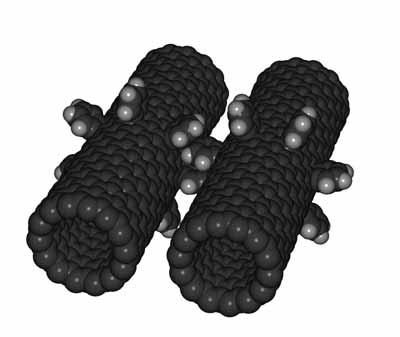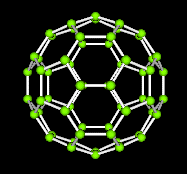 |
The
nanotube shown above has a length of only 4.3 nanometer. (A nanometer is a
billionth of a meter, or, about 1/80,000 of the diameter of a human hair)
|
Nanotechnology
The web defines
nanotechnology as any technology related to features of nanometer scale: thin
films, fine particles, chemical synthesis, advanced microlithography, and so
forth.
Nanotechnology is
therefore more of a 'catch-all' description of activities at the level of atoms
and molecules that have applications in the real world.
Although
nanotechnology stocks are in a frenzy, and the media talks of nanotechnology as
being the "new technology", research in the field has actually been
ongoing for many years.
In the last 15
years over a dozen Nobel prizes have been awarded in nanotechnology, including
the development of the scanning probe microscope (SPM), and the discovery of
fullerenes.
It was perhaps the
discovery and potential applications of the fullerene molecule (also called a
buckyball) and a related structure, the buckytube (or nanotube), that has
sparked the current interest in the field.
WHAT ARE
FULLERENES AND NANOTUBES?
These are both
compounds that are composed of carbon atoms. An example of a fullerene molecule
(shown below) is composed of 60 carbon atoms.
What is a Nanotube?
>Another interesting structure
is the nanotube (which can be described as a graphite sheet rolled up)
The nanotube shown above has a length
of only 4.3 nanometer. (A nanometer is a billionth of a meter, or, about
1/80,000 of the diameter of a human hair)
What
are the applications for nanotubes and fullerenes?
Carbon nanotubes (CNTs) have caught
the imagination of scientists for everything from superconductors to transistors
and diodes, material strengtheners, ion storage for batteries and more.
One of the most promising applications is a thin panel called a field
emitter display (FED). Both Motorola and DuPont are presently investigating
this application.
>More recently LSI Logic has
joined up with Nantero a Massachesetts-based startup company.
LSI is providing manufacturing research and development for a that is
creating a new kind of computer memory using carbon nanotubes.
LSI sees a product possibly as early as 2006.For each bit of memory,
multiple nanotubes are suspended above a metal electrode and charged.
Depending on the charge, the
flexible nanotube can bend upward, away from the electrode, or downward, into
contact with the electrode.
The resulting signals form the building blocks of a digital device.
"The best thing is, these switches are working," Norm
Armour from LSI said. "We built some
test devices, and we fired them up the other day, and they worked."
The nanotube-based memory can act like "flash" memory, a
reprogrammable type of memory that can retain data even when power is switched
off.
Fullerenes (C60) are being
investigated for their potential use as a drug-delivery system for cancer,
AIDS and other diseases.
A long term objective of
nanotechnology is to build nano-sized machines which can be inserted into the
human body in order to detect and repair diseased cells is a real possibility.
Current research however, is only at the primitive levels designing
simple components e.g., a carbon nanotube based gears (below) For more details
see 11th Foresight
Conference on Molecular Nanotechnology).
Below image shows Carbon nanotube
based gears. For further information,-- see the papers"Molecular Dynamics
Simulations of Carbon Nanotube Based Gears" by Jie Han and Al
Globus, MRJ, Inc., Richard Jaffe, NASA, and Glenn Deardorff, Sterling Software,
NASA Ames Research Center.
According to CMP Científica, a European nanotechnology information
company, over 600 companies are currently active in nanotechnology, from small
venture capital backed start-ups to some of the world's largest corporations
such as IBM and Samsung.
Governments and corporations worldwide have invested over $4 billion into
nanotechnology during the past year.
In addition many universities around the world have a nanotechnology
department which being a truly multidisciplinary field draws on scientists from
physics, chemistry, biology material science, electronics and medicine.





No comments:
Post a Comment